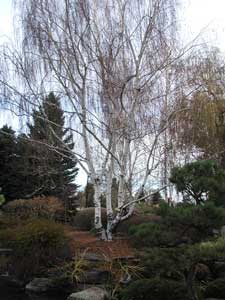Resource Library
Plant of the Week: White Birch
The University of Arkansas System Division of Agriculture does not promote, support or recommend plants featured in "Plant of the Week." Please consult your local Extension office for plants suitable for your region.
Plant of the Week
White Birch
Latin: Betula pendula

People with restraint always amaze me for I have little, especially when it comes to plants. As we develop the plantings for the Botanical Garden of the Ozarks in Northwest Arkansas, we recently had the opportunity to acquire an extensive collection of landscape-sized birches, many of them selections of the beautiful white barked European birch, Betula pendula. The price was right – they were free for the taking – so take them we did.
But white barked birches have about them a stigma. Birches are trees of the frozen north and loathe the heat of the South. And then there is the bronze birch borer, an insect common throughout the Midwest that kills trees at the prime of their life. Restraint would have been well advised, but if you’ve ever walked in a grove of these beauties you know their attraction.
Betula pendula is a 40-foot tall tree in the South with an erect form but drooping branches. The main trunk is a beautiful, chalky white with black markings where branches arise. The leaves are lance-shaped, 3 inches long and coarsely serrated on the edges. Fall color is yellow. This species has a light canopy of foliage so even in the summer the white trunk is prominently displayed.
Birches, which belong to their own family, don’t have showy flowers. Instead, their blooms are clusters of inch-long catkins at the ends of the branches. They’re wind pollinated and can be another source of pollen for spring time allergy suffers.
In the 1960s, birches were all the rage across the Midwest, and many spilled over into more southern locations as people moved about for work or retirement. They were mostly used as single specimens in the front lawn. Seldom did you see them planted in groves since they occur in the wild. Almost all of these trees are now gone, felled by either the bronze birch borer or the ravages of heat and prolonged drought.
The trees we acquired were part of an evaluation block developed by Dr. Mengmeng Gu while she worked on her Ph.D. program at the University of Arkansas Fayetteville under the direction of Dr. Jim Robbins, extension horticulturist. The goal of her research was to evaluate plant performance and identify plant physiological characteristics that might render certain species or selections better adapted to heat and drought stress.
Five years is not long to evaluate the adaptability of a species, so moving some of the trees to the Botanical Garden for long term evaluation seemed like a good extension of the project. Even if long term, as is often the case for birches, isn’t usually too long.
But does every tree planted in the garden have to outlive the gardener? Perhaps a decade of beautiful white bark in the winter is enough. Such justifications are easy to make when the trees are free and there’s plenty of room for a proper grove of assorted birch clones and species.
The European white birch is hardy to zone 2 in the north and will grow in zone 7, but is never completely at home that far south. It grows rapidly as a young tree, with the six-year-old trees we have mostly between 16 and 20 feet in height. While generally associated with moist sites in the wild, birches don’t need wet ground to grow in the landscape. Seed germination, especially following a fire, is best in wet sites so birch groves usually develop in these locations.
Birch borers will eventually become a limiting factor for our grove of white barked birches, but there will be no attempt to control them. As age and pestilence take their toll, the grove will shrink and make way for new additions to the garden. But while there, the birches will provide a grace and beauty few other trees can provide.
By: Gerald Klingaman, retired
Extension Horticulturist - Ornamentals
Extension News - May 18, 2007
The University of Arkansas System Division of Agriculture does not maintain lists of retail outlets where these plants can be purchased. Please check your local nursery or other retail outlets to ask about the availability of these plants for your growing area.